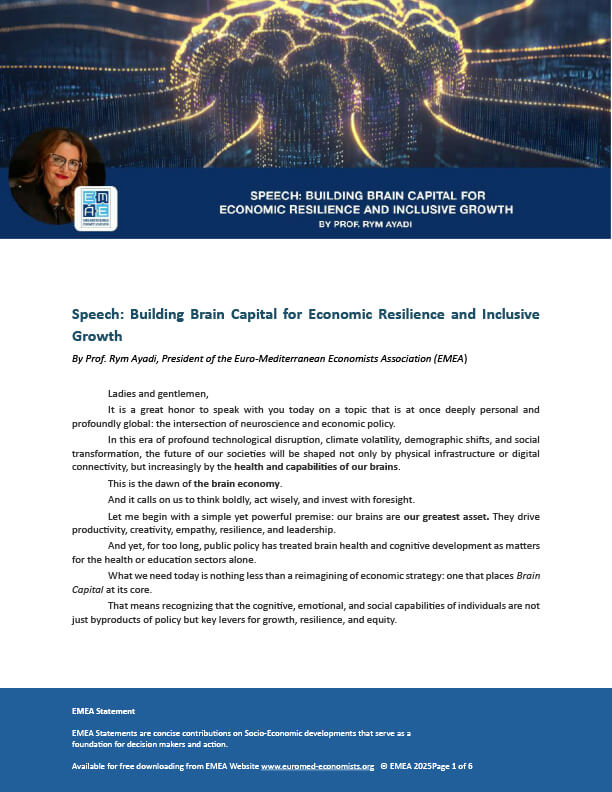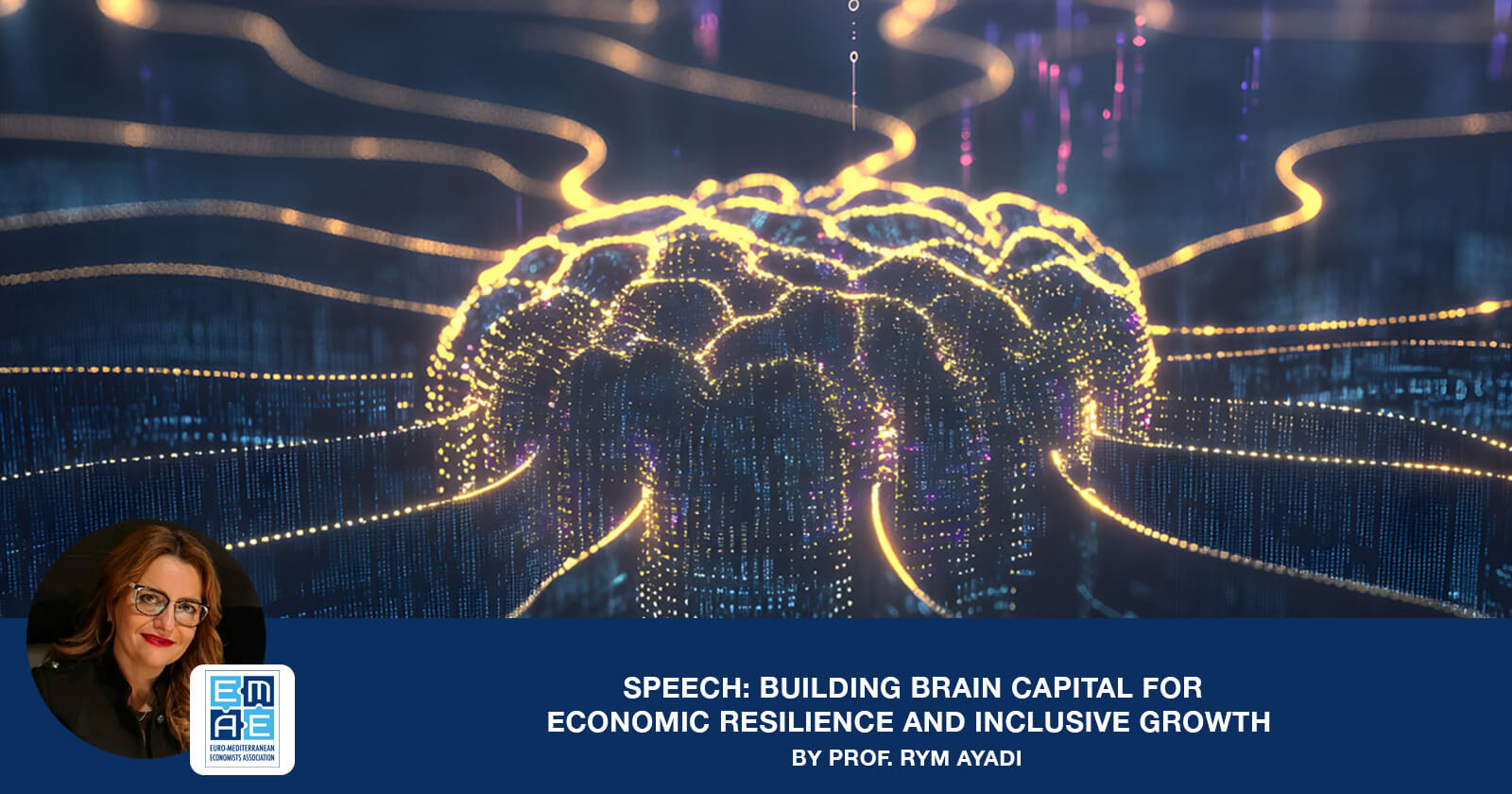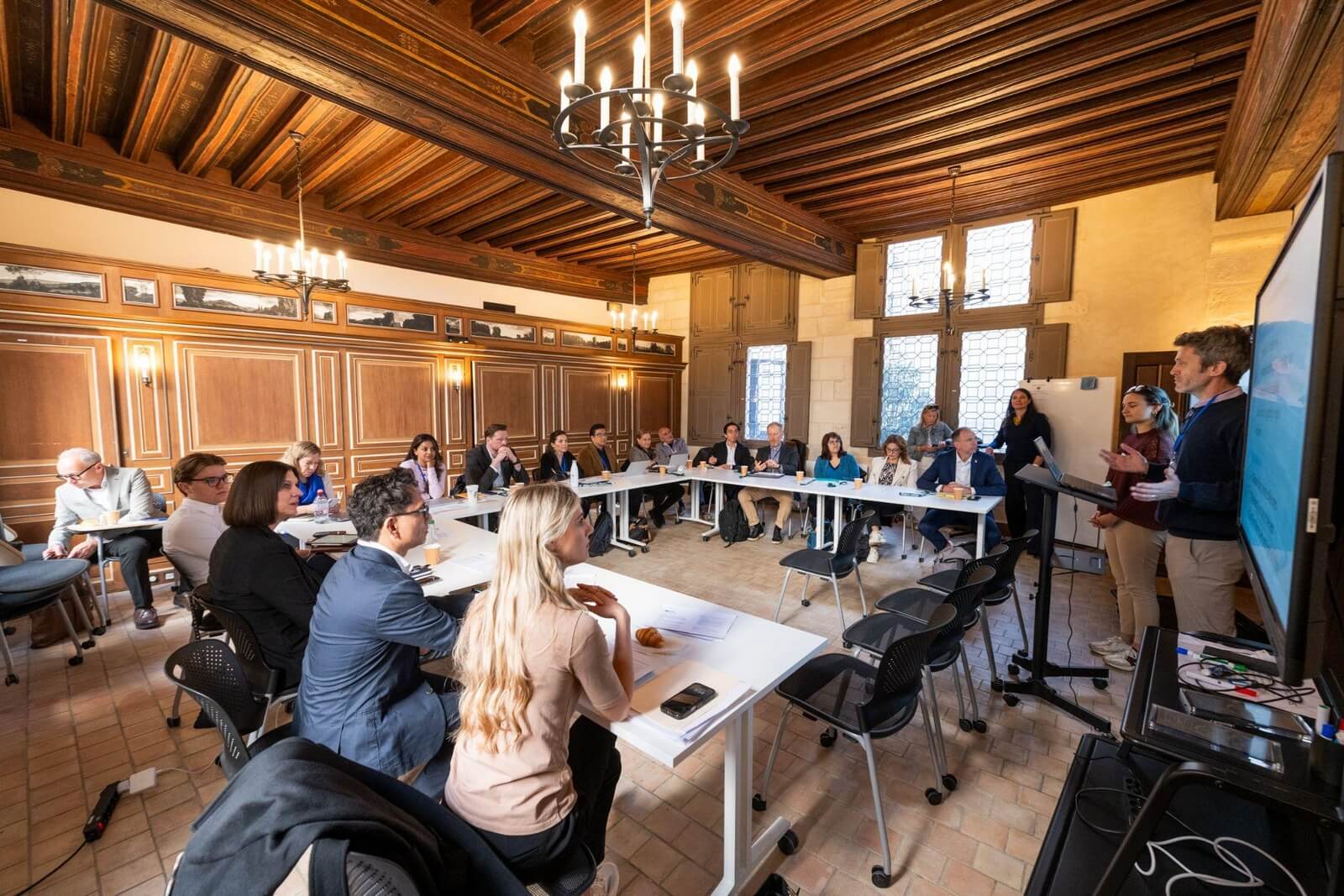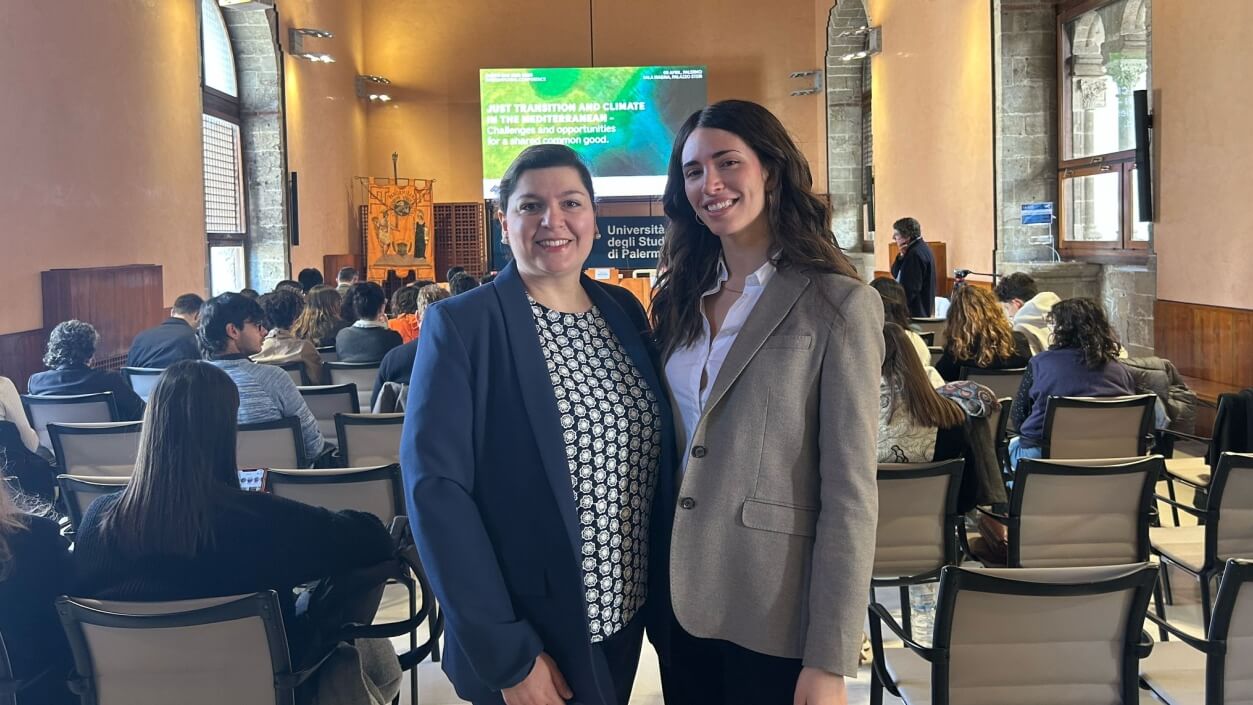By Prof. Rym Ayadi, President of the Euro-Mediterranean Economists Association (EMEA)
Ladies and gentlemen,
It is a great honor to speak with you today on a topic that is at once deeply personal and profoundly global: the intersection of neuroscience and economic policy.
In this era of profound technological disruption, climate volatility, demographic shifts, and social transformation, the future of our societies will be shaped not only by physical infrastructure or digital connectivity, but increasingly by the health and capabilities of our brains.
This is the dawn of the brain economy.
And it calls on us to think boldly, act wisely, and invest with foresight.
Let me begin with a simple yet powerful premise: our brains are our greatest asset. They drive productivity, creativity, empathy, resilience, and leadership.
And yet, for too long, public policy has treated brain health and cognitive development as matters for the health or education sectors alone.
What we need today is nothing less than a reimagining of economic strategy: one that places Brain Capital at its core.
That means recognizing that the cognitive, emotional, and social capabilities of individuals are not just byproducts of policy but key levers for growth, resilience, and equity.
Defining Brain Capital
At the Euro-Mediterranean Economists Association (EMEA), we define Brain Capital as the aggregation of brain health and brain skills that are essential for human flourishing and sustainable, inclusive economic growth.
Brain health includes mental, neurological, and substance use health, while brain skills span cognitive, emotional, and social capabilities.
Brain Capital recognizes that the human brain is both a driver of economic productivity and a vulnerable asset that needs investment and preservation.
Through the Global Brain Capital Dashboard, we measure and monitor key indicators such as education access and quality, innovation capacity, prevalence of mental illness, and availability of cognitive health services to inform policy interventions that build Brain Capital at national and regional levels.
The Economic Burden of Inaction
Let us consider the scale of the challenge. Brain disorders like depression and anxiety cost the global economy over $5 trillion each year, a figure expected to raise $ 16 trillion by 2030 in lost productivity.
Stroke, a sudden and often disabling neurological event, costs us upwards of $600 billion annually. And dementia—with its relentless toll on individuals and families—already costs $1.3 trillion globally, projected to nearly double by 2030.
But these figures, as staggering as they are, only scratch the surface.
The real burden is hidden in lost potential: the student who cannot focus due to chronic stress; the worker who drops out of the labor force due to untreated anxiety; the caregiver who leaves their job to look after a loved one with dementia.
These conditions do not just strain our health systems. They suppress our GDP, deepen inequality, and corrode social cohesion.
The Case for Investing in Brain Capital
Now here is the good news: we can change this trajectory.
The science is clear. Investing in mental health, early childhood development, education informed by neuroscience, and workplace mental wellbeing yields high returns. For every dollar invested in treating depression and anxiety, we see a fourfold return in improved health and productivity.
Evidence from across the world supports this. In Singapore, depression and anxiety are estimated to cost nearly 3% of GDP—mostly due to lost productivity. In Europe, mental ill-health costs more than 4% of GDP. And yet, most countries spend just 2% or less of their health budgets on mental health.
This is not just an economic oversight. It is a structural failure that promotes a brain negative economy.
A New Paradigm for Policy Design
So, what would it look like to design policy with brain science in mind?
First, it means understanding how people actually make decisions. Behavioral economics and neuroeconomics show us that humans are not perfectly rational actors. We are emotional, social, and biased in predictable ways.
Second, it means preserving and enhancing brain health across the lifespan. Early childhood interventions, school-based cognitive skill programs, and campaigns to destigmatize mental illness are not luxuries—they are foundational investments. Aging societies must also prioritize cognitive longevity and the build up of cognitive reserve, with dementia strategies that support families and invest in care infrastructure.
Third, it means integrating brain health into other domains: climate policy, urban design, labor markets. For example, green spaces improve cognitive function. Social safety nets reduce toxic stress. And workplaces that foster psychological safety are more innovative and productive.
Global Leadership and the Brain Capital Grand Strategy
Fortunately, we are not starting from scratch. The Brain Capital Grand Strategy and the Brain Capital Alliance, developed by a global coalition of researchers, economists, and policy thinkers, offers a blueprint for action. It proposes a “Brain Capital in All Policies” approach—where every major policy is assessed for its impact on brain health and skills.
International organizations are responding. The OECD has championed the behavioral insights movement – Neuroscience policy initiative. The WHO has launched a brain health framework. UNESCO is translating the science of learning into classroom practice. And countries like Australia, France, Finland, and Chile are embedding brain science into education, social policy, and even constitutional rights.
Healthcare: Brain Health, Dementia, and Mental Health Policies
Neuroscience has also become a cornerstone of health policy, especially in brain health initiatives, dementia strategies, and mental health system reform.
The World Health Organization (WHO) now frames “optimizing brain health” as a public health priority across the lifespan (Optimizing brain health across the life course: WHO position paper).
In 2022 WHO released a position paper and a Global Action Plan on Epilepsy and Neurological Disorders (2022–2031) urging countries to integrate brain health promotion into all ages and sectors. The WHO emphasizes that improving brain health (through healthy environments, education, safety, and healthcare access) not only reduces neurological disorder burden but also improves mental and physical health with broad social benefits This reflects a shift in policy thinking: rather than siloing “brain” issues as solely medical, governments are treating brain health as integral to general health and wellbeing.
One major focus is dementia policy. As neuroscience has illuminated modifiable risk factors and early biomarkers for dementias like Alzheimer’s, many nations have developed ambitious dementia strategies. A recent evaluation of seven countries (China, Germany, Japan, South Korea, Sweden, the UK, and the USA) found that six have launched public health initiatives for dementia risk reduction, prevention, and early detection, and five explicitly emphasize “early action” in their national plans ( Evaluation of major national dementia policies and health‐care system preparedness for early medical action and implementation – PMC ) For example, following findings that up to 40% of dementia cases might be preventable by addressing factors such as education, exercise, and hypertension policies now target lifestyle and vascular health as “brain health” interventions. South Korea stands out for a comprehensive approach: since 2008 it has implemented four national dementia plans, and since 2010 a National Dementia Early Detection Program set up over 250 community “memory centers” (called ansim centers) offering regular cognitive screening and referrals. As a result, far more Koreans are being diagnosed in earlier stages of dementia, enabling timely care. While cost-effectiveness of mass screening is still debated, South Korea’s experience shows that when governments provide easy access to dementia check-ups, the public uses them, leading to more diagnoses and awareness. Other countries are following suit: England’s NHS set diagnosis rate targets and memory clinics, Japan’s “Orange Plan” trains thousands of dementia support workers, and the U.S. FDA has even approved early-stage Alzheimer’s therapies, reflecting a policy pivot toward early intervention. International bodies like the OECD and WHO facilitate knowledge exchange on these strategies – for instance, WHO’s Global Dementia Observatory helps track policy progress and encourages all countries to develop national dementia plans in line with neuroscience advances.
In mental health, neuroscience is gradually reshaping policies to treat mental illness as brain disorders that require mainstream health care. The WHO’s Comprehensive Mental Health Action Plan (2013–2030) and its Mental Health Gap Programme call for integrating mental health into primary care and general health systems ( Mental health in primary care: illusion or inclusion? ). The rationale is backed by neuroscience and epidemiological evidence: mental and substance use disorders often have neurodevelopmental roots and are leading causes of disability, yet the treatment gap remains enormous. Integrating mental health services into primary care makes care more accessible and helps fight stigma by framing mental illness as treatable health conditions. Many countries have begun such integration. For example, Zimbabwe’s Friendship Bench program trains community health workers in basic psychotherapy; Australia and the UK fund GP clinics to employ mental health nurses; and the United States implemented mental health parity laws so insurance covers mental illness like any other medical condition – an acknowledgment that brain disorders deserve equal treatment. Notably, California’s recent ACEs Aware initiative links pediatric primary care with neuroscience: it reimburses doctors to screen for Adverse Childhood Experiences (ACEs) – like abuse or extreme stress – because studies show toxic stress in childhood alters brain development and elevates lifetime health risks (Case Study: California’s ACEs Aware Initiative). Launched in 2020 under the Surgeon General, this statewide policy trains providers to detect trauma early and intervene, aiming to reduce toxic stress by 50% in a generation. Such trauma-informed policies, now spreading to other U.S. states, are grounded in neuroscience findings about stress, brain plasticity, and resilience.
Neuroscience is also driving reforms in psychiatric care and research. National research initiatives like the U.S. BRAIN Initiative and EU’s Human Brain Project (and similar programs in Japan and China) are pouring resources into neuroscience, expecting breakthroughs in treatments for depression, PTSD, addiction, and more. Policymakers increasingly view investment in brain research as a strategy to reduce the societal burden of mental and neurological illness in the long term. At the same time, there’s recognition that policy must balance biomedical advances with human rights and ethics. The 2018 Lancet Commission on Global Mental Health noted that while neuroscience can help position mental health as a development priority, policies must avoid over-reductionism and ensure dignity and justice for patients ( Neuroscience for Global Mental Health – PMC ). In practice, this means combining brain-based approaches (e.g. expanding access to medications or neuromodulation therapies) with psychosocial supports. Countries like New Zealand and Canada have moved toward a “recovery” model in mental health, informed partly by evidence that social connection and environment significantly affect brain outcomes in mental illness. Overall, neuroscience has elevated mental health on the policy agenda (e.g. being included in noncommunicable disease strategies and the UN Sustainable Development Goals), and it is providing new tools and vocabulary (“brain health”, biomarkers, early intervention models) that are reshaping how governments plan services. As WHO succinctly states: integrating mental health into primary care is both necessary and still under-implemented, remaining a “largely unrealized goal” despite robust evidence ( Mental health in primary care: illusion or inclusion? ). Bridging that gap is now a key policy challenge that many nations are tackling with support from international guidelines.
What Comes Next
But we must go further. We need national brain capital strategies that are cross-sectoral, measurable, and adequately financed.
We need metrics—like a Brain Capital Index—to track progress. And we need public-private partnerships to scale innovation.
Let us imagine what such a future could look like:
- Children in every community receiving nurturing, brain-enriching early education.
- Workplaces that prioritize mental wellness as much as physical safety.
- Older adults supported to live with dignity and cognitive vitality.
- Public policies that align with how the human brain really works.
A Call to Action
This is not a utopia. It is within our reach.
The brain economy is here. Our task is to build the institutions, incentives, and imagination to make it flourish.
So let us place Brain Capital where it belongs: at the center of economic policy, human development, and global recovery.
Because when we invest in brains, we invest in everything.
Thank you.
Link to the speech video: https://youtu.be/FM6GOdLfu2g
Related links:
- Link to the EMEA Global Brain Capital Dashboard
- Empowering the Global Brain Economy: Key Milestones of 2024 and the Road Ahead
- Transforming brain health into a strategic investment through brain capital
- Building the Future: Brain and Nature Capital as Pillars of a Well-being Economy
- Turning Brain Drain into Brain Gain: Europe’s Opportunity to Lead a Brain-Positive Economy
Link of the video course at the Icarus AI platform: Brain Capital as a driver of Economic Policy
Prof. Rym Ayadi, EMEA President, and co-founder of the Brain Capital Alliance & the Brain Economy Hub, delivered the keynote speech “Building Brain Capital for Economic Resilience and Inclusive Growth” at the Global Summit on Neuroscience and Neurological Disorders (Neuroscience 2025), which was held in Valencia, Spain from April 07-09, 2025.
The Neuroscience 2025 summit brought together professionals in the field of neuroscience to present, share, and innovate solutions and breakthroughs in addressing challenging problems, providing a high-level forum to stimulate ideas and establish collaborations.





